Nestled in the remote northeastern corner of Uganda, Kidepo Valley National Park stands as one of Africa’s last true wilderness frontiers. Often described as “the most picturesque park in Africa” by CNN, this hidden gem offers an authentic safari experience far from the crowded tourist trails. With its sweeping savannah plains, rugged mountain landscapes, and remarkable biodiversity, Kidepo rewards the adventurous traveler with wildlife encounters that feel like stepping back in time to an unspoiled Africa.

The stunning savannah landscape of Kidepo Valley National Park
Location and How to Get to Kidepo Valley National Park
Located in Uganda’s northeastern Karamoja region, Kidepo Valley National Park spans 1,442 square kilometers of pristine wilderness. The park sits in a remote corner where Uganda meets South Sudan and Kenya, approximately 700 kilometers from Kampala. Its isolation has been both its preservation and challenge – keeping it authentic while making it less accessible than other Ugandan parks.
Getting There By Road
The journey to Kidepo is an adventure in itself. There are several routes to reach this remote paradise:
- Kampala-Karuma-Gulu-Kitgum-Kidepo (571km): The most popular and shortest route, taking approximately 10 hours.
- Kampala-Karuma-Lira-Kotido-Kidepo (705km): An alternative route through central Uganda.
- Kampala-Mbale-Sironko-Kotido-Kaboong-Kidepo (740km): Eastern route passing through scenic mountain regions.
- Kampala-Mbale-Soroti-Kidepo (792km): Longest but offers diverse landscapes.
A 4×4 vehicle is essential for this journey, especially during the rainy season when roads can become challenging. Many travelers break their journey with an overnight stay in Gulu or Kitgum.
Flying to Kidepo
For those preferring to skip the long drive, scheduled flights operate from Entebbe International Airport or Kajjansi Airfield to Apoka Airstrip within the park. The flight takes approximately 2 hours and offers spectacular aerial views of Uganda’s diverse landscapes. Airlines like Aero Link and Bar Aviation offer regular services, while charter flights provide more flexibility for your travel schedule.
Ready to Experience Kidepo’s Wilderness?
Book your flight or arrange ground transportation with experienced operators who know the best routes.
Explore Transportation Options
Park History and Significance
Kidepo Valley National Park has a rich history that reflects Uganda’s conservation journey. Originally gazetted as a game reserve in 1958, it was elevated to national park status in 1962, coinciding with Uganda’s independence. The primary goal was to protect the unique ecosystem and prevent poaching that threatened wildlife in the region.
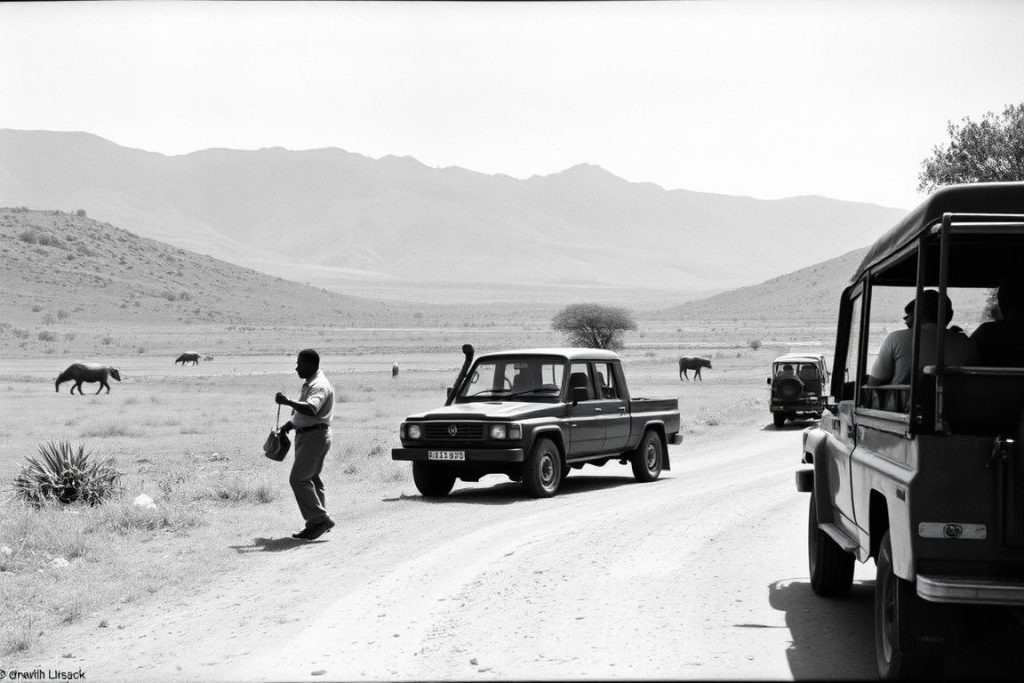
Early conservation efforts in Kidepo Valley during the 1960s
During the political turbulence of the 1970s and 1980s, the park faced significant challenges from poaching and neglect. Wildlife populations declined dramatically, with species like rhinos being hunted to local extinction. The park’s remote location became both a blessing and curse – difficult to access for tourists but also challenging to protect.
Since the early 2000s, the Uganda Wildlife Authority has implemented comprehensive conservation programs that have revitalized the park. Today, Kidepo stands as a conservation success story, with rebounding wildlife populations and growing recognition as one of Africa’s most spectacular wilderness areas.
Cultural Significance
The land surrounding Kidepo Valley National Park is home to the Karamojong people, semi-nomadic pastoralists with a rich cultural heritage, and the smaller Ik tribe who inhabit the slopes of Mount Morungole. These communities have traditional connections to the land that date back centuries, and their cultural practices are deeply intertwined with the natural environment.
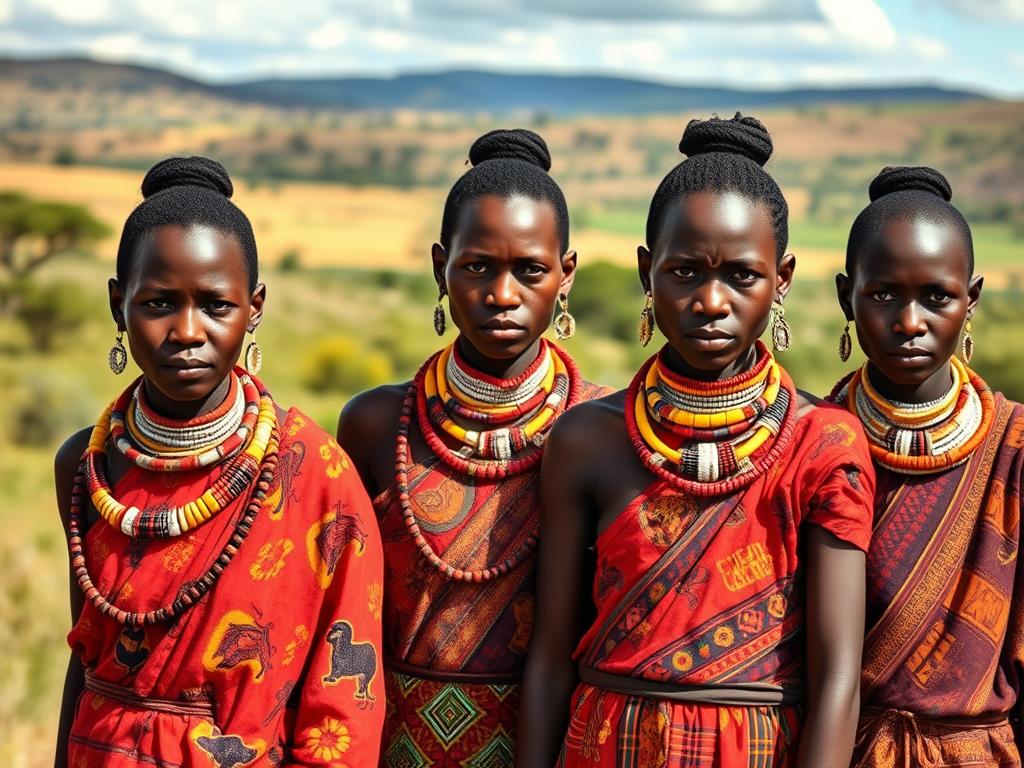
The Karamojong people maintain their traditional way of life near the park
The Uganda Wildlife Authority works closely with these communities through collaborative management agreements that allow sustainable resource harvesting while protecting the park’s ecological integrity. This partnership approach has helped transform local attitudes toward conservation and created economic opportunities through tourism.
Unique Wildlife of Kidepo Valley National Park
Kidepo Valley National Park boasts an impressive array of wildlife, including 77 mammal species and nearly 475 bird species. What makes the park truly special is that 28 of these mammals cannot be found in any other Ugandan national park, making it a unique destination for wildlife enthusiasts.
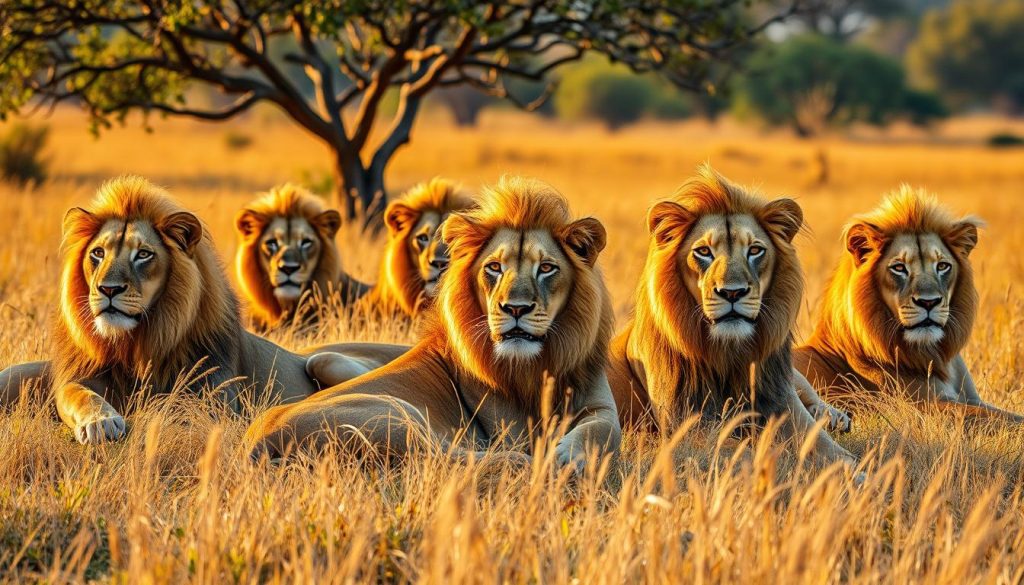
The magnificent Kidepo lions are known for their impressive manes
The Big Cats and Predators
Kidepo is renowned for its healthy population of big cats. The park’s lions, particularly the males with their magnificent manes, are a highlight for many visitors. These “Kidepo lions” are often spotted lounging on rocky outcrops or in the branches of sausage trees in the Narus Valley.
Other predators include cheetahs racing across the open plains, leopards lurking in the riverine vegetation, and spotted hyenas patrolling at dawn and dusk. More unusual carnivores include the bat-eared fox, striped hyena, aardwolf, and caracal – species rarely seen in other Ugandan parks.
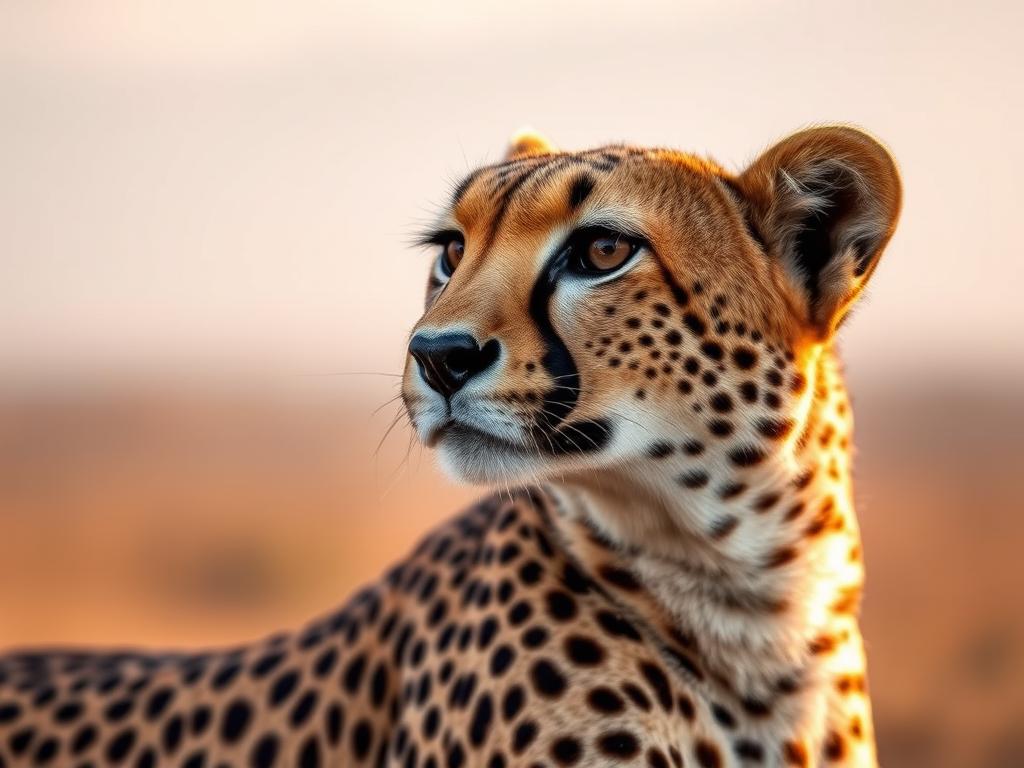
A cheetah surveys its territory in the open plains
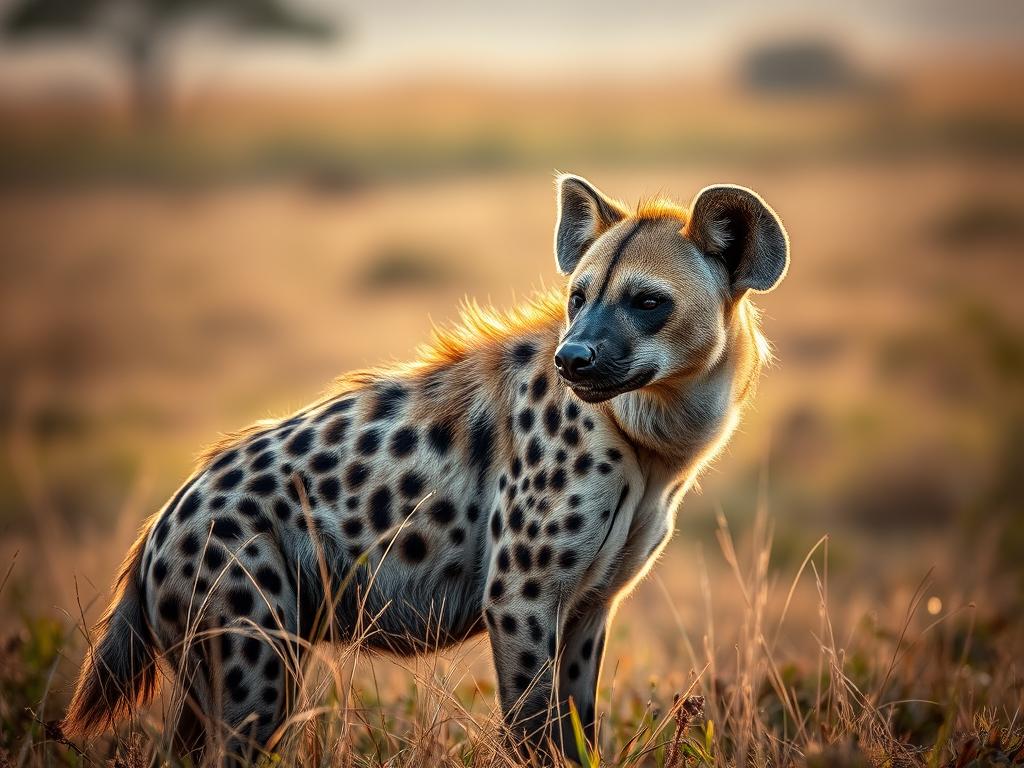
Spotted hyenas are active during dawn and dusk
Herbivores and Plains Game
The savannah plains support large herds of buffalo, while elegant Rothschild’s giraffes browse among the acacia trees. Kidepo is the only park in Uganda where you can see both zebras and giraffes together. Other herbivores include elephants, Jackson’s hartebeests, oribi, eland, bushbucks, bush duikers, Defassa waterbucks, Bohor reedbucks, and Uganda kobs.
Some of the more unusual antelope species include the greater and lesser kudu, Guenther’s dik-dik, and klipspringer – all adapted to the semi-arid environment that characterizes parts of the park.
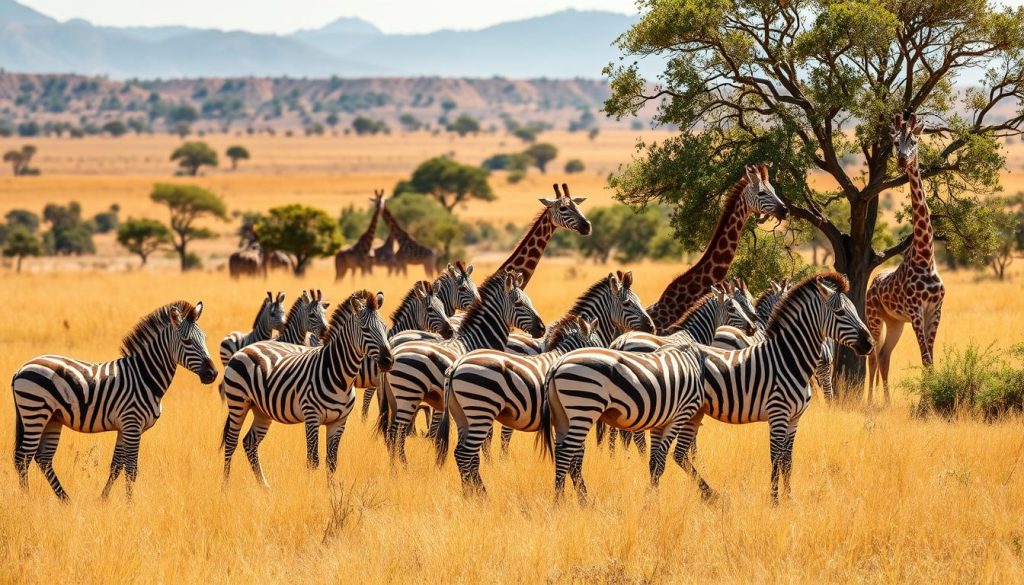
Kidepo is the only place in Uganda where you can see zebras and giraffes together
Incredible Birdlife
With nearly 475 bird species recorded, Kidepo Valley National Park is a paradise for birdwatchers. The park’s diverse habitats support an impressive variety of birds, including 58 species of raptors. Notable species include the ostrich (found nowhere else in Uganda), Kori bustard, secretary bird, and Abyssinian ground hornbill.
Birding enthusiasts should look for the Karamoja apalis, an endemic species, as well as the purple heron, Abyssinian roller, Abyssinian scimitarbill, and various bee-eaters. The park is also home to 14 species of eagles, including the martial eagle and Verreaux’s eagle.

Ostriches can only be seen in Kidepo within Uganda

The vibrant Abyssinian Roller is a favorite among birders
Experience Kidepo’s Extraordinary Wildlife
Join expert guides who know exactly where to find the park’s most elusive species.
Breathtaking Landscape Features
Kidepo Valley National Park’s landscape is characterized by dramatic contrasts – from rolling savannah plains to rugged mountain ranges. This diverse topography creates a variety of habitats that support the park’s rich biodiversity while offering visitors spectacular scenery at every turn.

The stunning Narus Valley bathed in golden light
Narus Valley
The Narus Valley is the heart of wildlife activity in Kidepo, especially during the dry season when it retains water while other areas dry up. The name “Narus” in the local Karamojong dialect means “muddy” or “soggy ground,” reflecting its ability to hold water longer than surrounding areas.
This lush valley features open grasslands dotted with acacia trees and borassus palms, creating a classic African savannah landscape. The valley floor is intersected by the seasonal Narus River, which forms pools and oases that attract wildlife from across the park.
For visitors, the Narus Valley offers the park’s best game viewing opportunities. The Apoka Rest Camp and tourism center are strategically located here to take advantage of these wildlife concentrations.
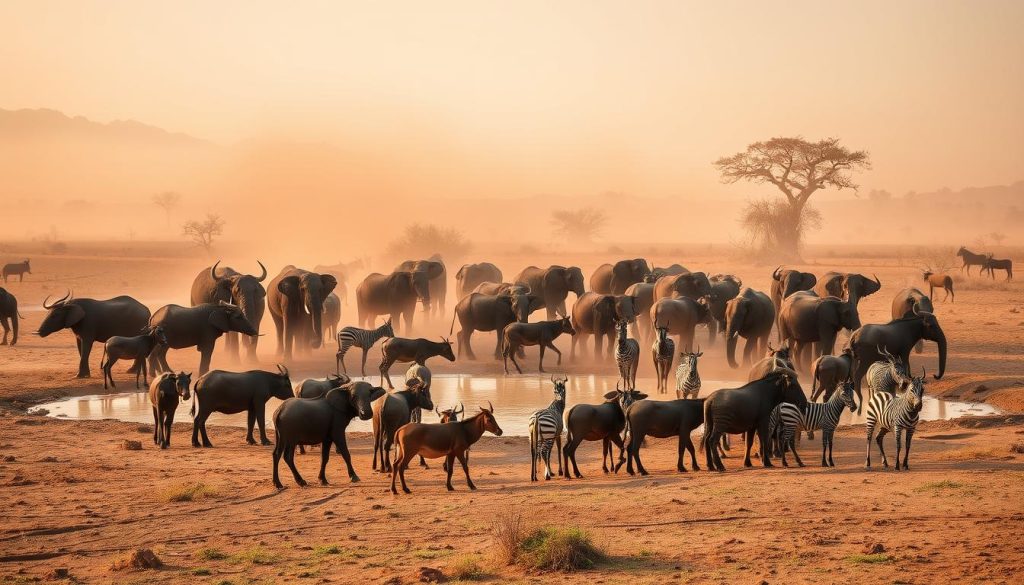
Wildlife congregates around waterholes in Narus Valley during the dry season
Kidepo Valley
The park’s namesake, Kidepo Valley, offers a stark contrast to Narus. In the local dialect, “Kidepo” loosely translates to “to pick from under,” possibly referring to the gathering of fallen borassus palm fruits that dot the valley floor.
The Kidepo Valley is characterized by its distinctive borassus palms scattered throughout the landscape. The seasonal Kidepo River flows northward into South Sudan during the rainy season but transforms into expansive sand rivers during the dry months.
While wildlife is less concentrated here than in Narus Valley, the Kidepo Valley offers unparalleled scenic beauty and opportunities for walking safaris during the dry season when animals have migrated elsewhere.

Distinctive borassus palms dot the landscape of Kidepo Valley
Mount Morungole
Rising to 2,750 meters above sea level, Mount Morungole forms part of the mountainous border between Uganda and South Sudan. This imposing mountain range is the source of both the Kidepo and Narus rivers that sustain life throughout the park.
Mount Morungole is not just a geographical feature but also a cultural landmark. It is the ancestral home of the Ik people, one of Uganda’s smallest ethnic groups who were displaced from the valley when the national park was established.
Hiking enthusiasts can trek up Mount Morungole for breathtaking panoramic views of the entire park and beyond. The mountain slopes are covered in montane forest that supports unique bird species not found in the valleys below.
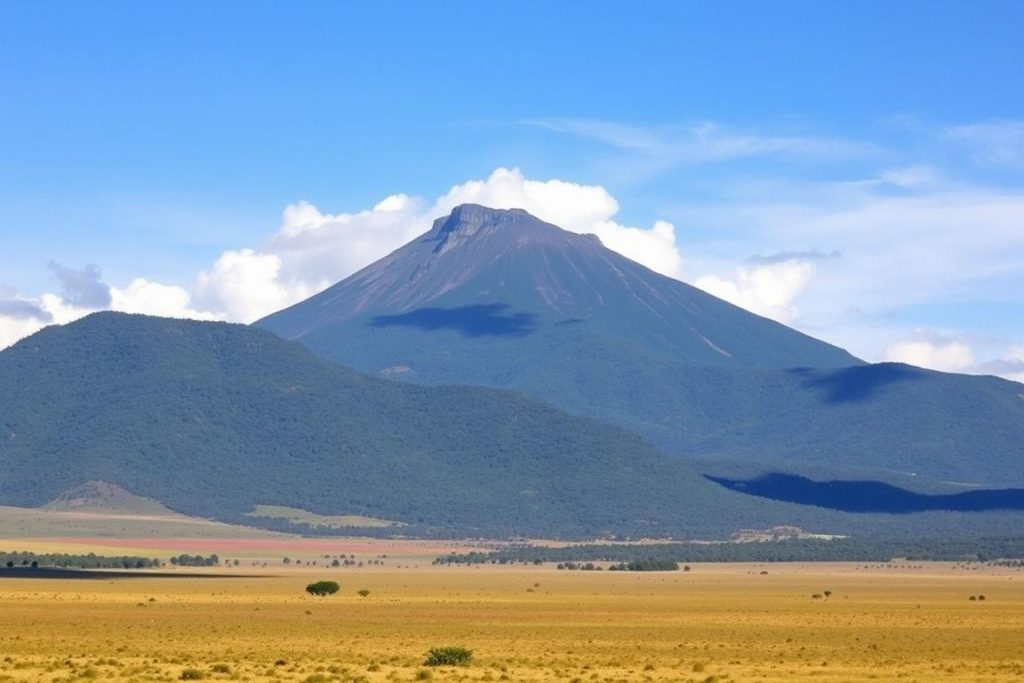
The majestic Mount Morungole forms a dramatic backdrop to the park
Kanangorok Hot Springs
Located just 11 kilometers from the Kidepo River, the Kanangorok Hot Springs are a fascinating geological feature. These natural hot springs bubble up from beneath the earth’s surface, creating pools of warm water amid the otherwise dry landscape.
Local communities consider the hot springs sacred, believing in their healing properties. For visitors, they offer a unique attraction and a pleasant place for picnicking after a game drive.
The journey to the hot springs takes you through beautiful landscapes and offers additional wildlife viewing opportunities along the way.
Best Safari Activities in Kidepo Valley National Park
Kidepo Valley National Park offers a diverse range of activities that allow visitors to experience its wilderness from different perspectives. From traditional game drives to cultural encounters, there’s something for every type of traveler.
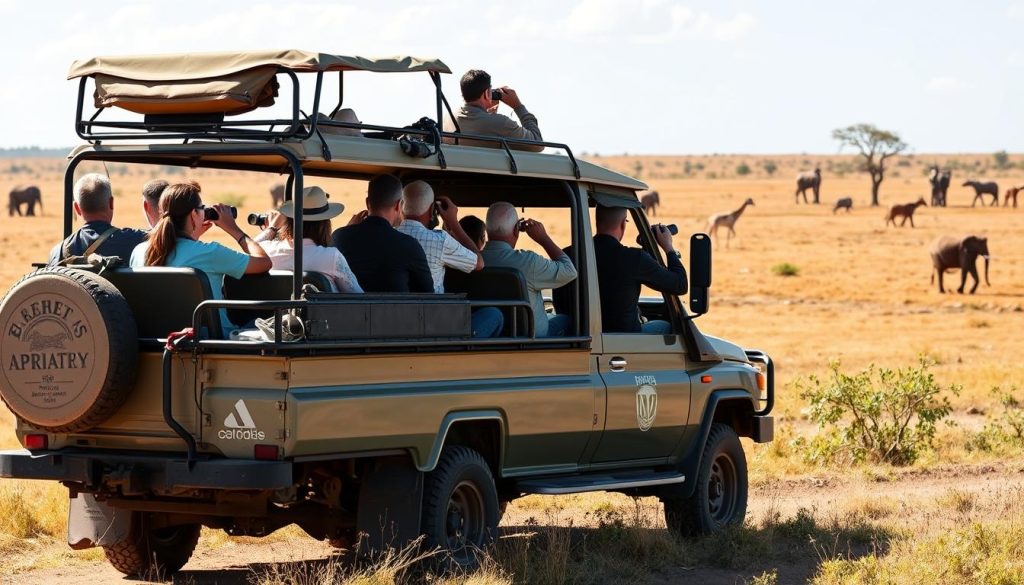
Game drives offer the classic safari experience in Kidepo
Game Drives
Game drives remain the most popular way to explore Kidepo Valley National Park. Early morning (around 6:00 AM) and late afternoon (from 4:00 PM) drives offer the best wildlife viewing opportunities when animals are most active.
The park has well-maintained tracks through the Narus Valley that lead to prime wildlife viewing areas. Hiring a Uganda Wildlife Authority ranger guide is highly recommended as they know the best spots and can interpret animal behavior and tracks.
During the dry season (December to February), game drives concentrate around remaining water sources where animals gather in large numbers. The open savannah landscape makes wildlife spotting relatively easy compared to more forested parks.
Guided Nature Walks
For those who prefer a more intimate connection with nature, guided walks offer a completely different perspective on the park’s ecosystem. These walks allow you to notice smaller details – from insects and reptiles to plant adaptations and animal tracks – that might be missed from a vehicle.
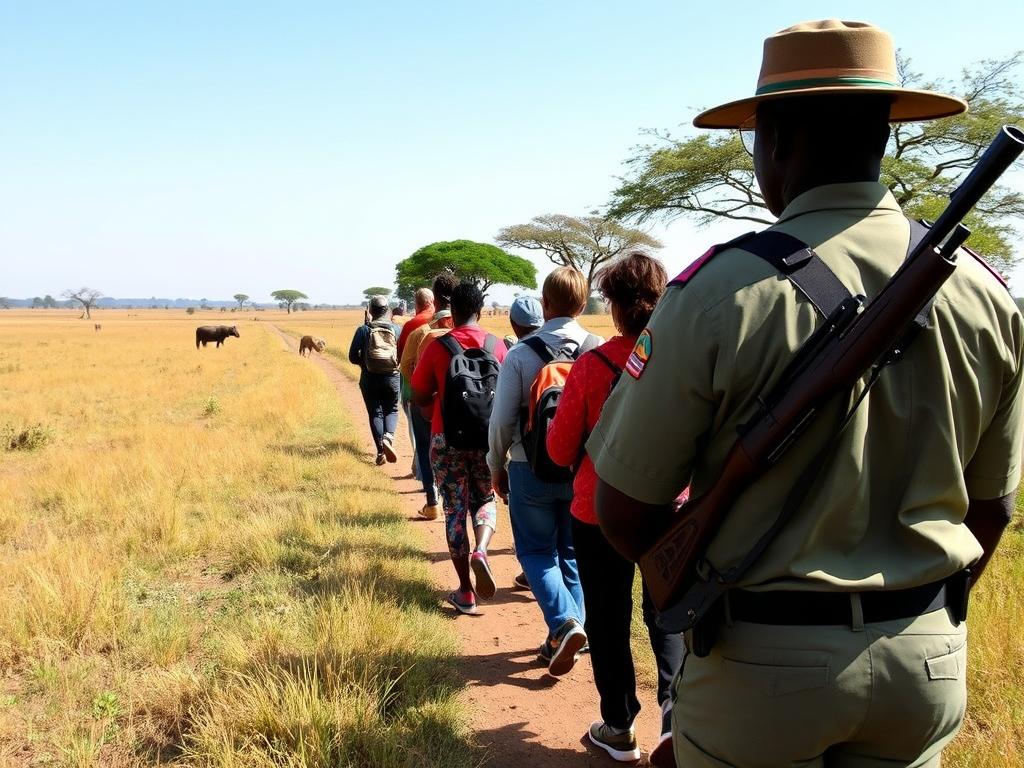
Experienced rangers lead nature walks through the park’s diverse habitats
Popular walking routes include the Narus Valley during the wet season when wildlife is more dispersed, and the dry Kidepo River bed during the dry season. The Namamukweny Valley (“the place with no birds” in the local language) ironically offers excellent birding opportunities on foot.
All walks must be accompanied by an armed ranger guide for safety, as this is genuine wilderness with free-roaming predators.
Hiking Mount Morungole
For the adventurous traveler, hiking up Mount Morungole offers a challenging but rewarding experience. The trek takes you through changing vegetation zones, from savannah to montane forest, with increasing biodiversity as you ascend.
From the summit, you’ll enjoy spectacular panoramic views across Kidepo Valley National Park and into neighboring South Sudan and Kenya. The hike is best undertaken early in the morning before temperatures rise too high.
This activity requires good physical fitness and should be arranged in advance with the park authorities who will provide an armed ranger escort.
Cultural Encounters
The communities surrounding Kidepo Valley National Park offer rich cultural experiences that complement wildlife viewing. Visiting a Karamojong manyatta (homestead) provides insights into the traditional pastoralist lifestyle of these resilient people.
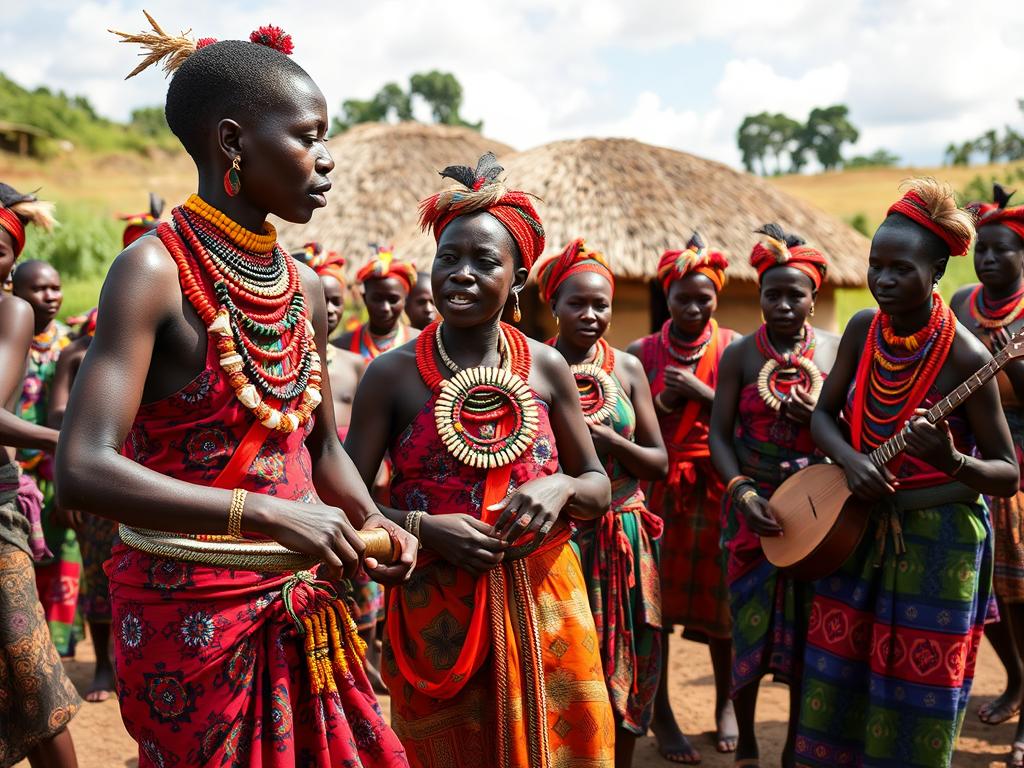
Cultural performances showcase the rich traditions of the Karamojong people
More adventurous travelers can arrange a visit to the Ik people on Mount Morungole. This small ethnic group of about 10,000 people maintains many traditional practices, including honey gathering techniques passed down through generations.
Cultural tours can be arranged through the Uganda Wildlife Authority or your accommodation. It’s customary to bring small gifts when visiting local communities.
Birding Safaris
With nearly 475 bird species, Kidepo offers exceptional birding opportunities throughout the year. The park’s location at the intersection of East African and Horn of Africa biomes means it hosts species not found elsewhere in Uganda.
Prime birding locations include the Apoka Rest Camp area, Narus Valley wetlands, and the Namamukweny Valley. Specialized birding guides can help you spot rarities like the Karamoja apalis, white-bellied go-away bird, and Abyssinian scimitarbill.
The best time for birding is during the wet season (April to August) when migratory species are present and resident birds are in breeding plumage.
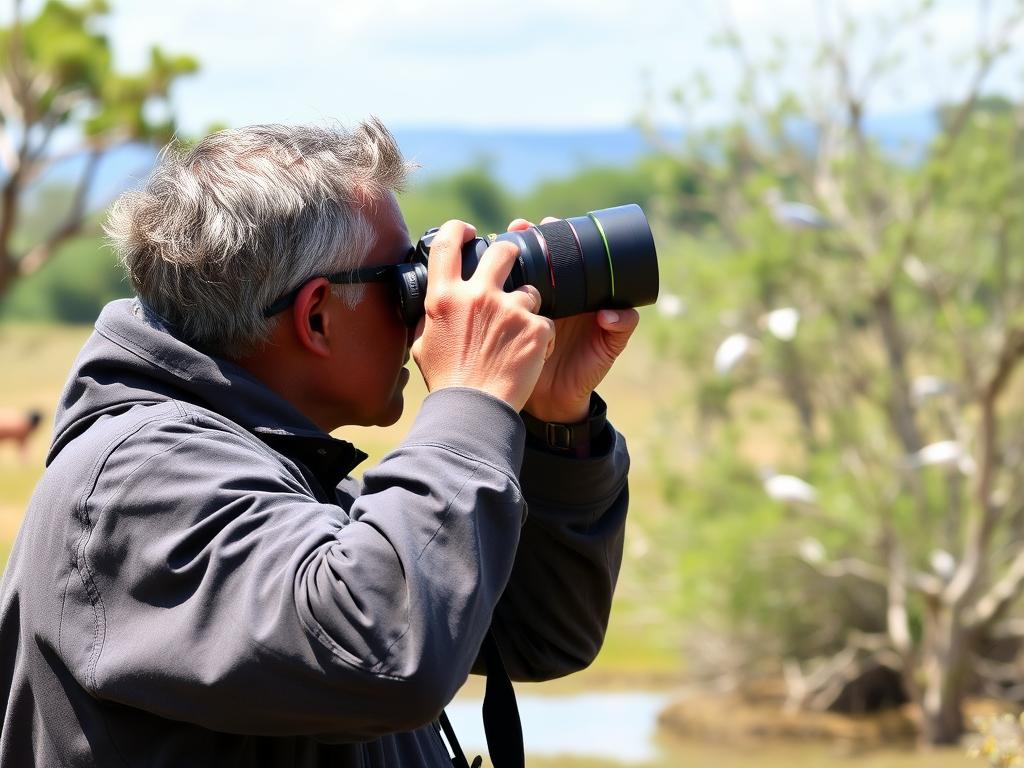
Birdwatchers can spot many rare species in Kidepo’s diverse habitats
Create Your Perfect Kidepo Adventure
Customize your safari experience with activities tailored to your interests and fitness level.
Best Time to Visit Kidepo Valley National Park
Kidepo Valley National Park can be visited year-round, but different seasons offer distinctly different experiences. Understanding the seasonal patterns will help you plan a trip that aligns with your wildlife viewing priorities and comfort preferences.

The dramatic transformation between dry and wet seasons in Kidepo
Dry Season (December to February)
The dry season is considered the prime time for wildlife viewing in Kidepo. As water sources dwindle, animals concentrate around remaining waterholes in the Narus Valley, making them easier to spot. The vegetation is also less dense, improving visibility.
This period offers the most reliable game viewing experiences, with large herds of buffalo, elephants, and various antelope species gathering at water sources. Predators naturally follow, creating opportunities to witness hunting behavior.
However, this is also the hottest time of year, with daytime temperatures regularly exceeding 35°C (95°F). The landscape appears parched, and dust can be an issue during game drives.
Wet Season (April to August)
The main rainy season transforms Kidepo into a lush green paradise. The savannah comes alive with fresh grass, wildflowers bloom, and migratory birds arrive in large numbers, making this the best time for birding enthusiasts.
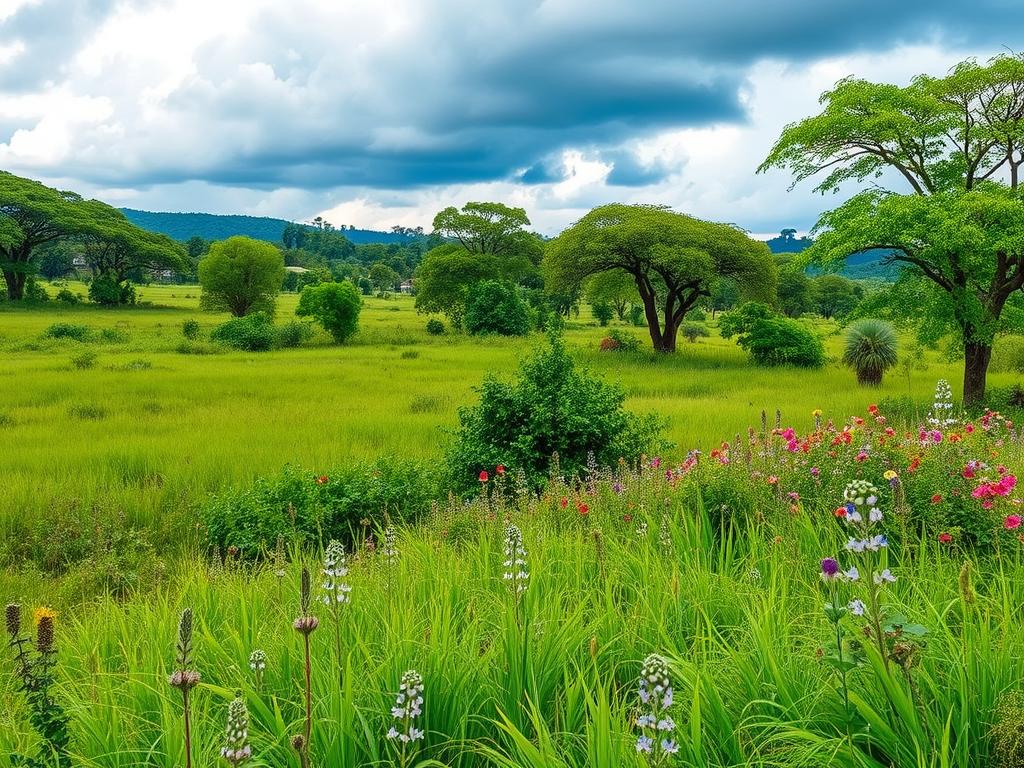
The wet season brings a vibrant green transformation to the landscape
Wildlife disperses widely during this period as water and food become available throughout the park. This means game viewing requires more patience and exploration, but the reward is seeing animals in a beautiful, verdant setting.
Road conditions can be challenging during heavy rains, and some tracks may become temporarily impassable. A 4×4 vehicle is absolutely essential during this season.
Transition Periods (March and September to November)
The transition months offer a balance between the extremes of wet and dry seasons. March sees the landscape beginning to dry out after short rains, while September to November (with a short rainy period) represents the transition from wet to dry.
These periods can offer excellent wildlife viewing with fewer visitors, more moderate temperatures, and still-green landscapes. September and October are particularly good months to visit as the grass begins to shorten but remains green enough to create beautiful scenery.
November sees the start of the migration back to the Narus Valley as other water sources begin to dry up, creating good wildlife concentrations without the extreme heat of the peak dry season.
| Season | Months | Wildlife Viewing | Landscape | Road Conditions | Temperature |
| Dry Season | December-February | Excellent | Golden, parched | Good | Very hot (30-40°C) |
| Wet Season | April-August | Good but dispersed | Lush, green | Challenging | Moderate (20-30°C) |
| Transition | March, Sept-Nov | Very good | Mixed green/gold | Variable | Warm (25-35°C) |
Accommodation Options in Kidepo Valley National Park
Despite its remote location, Kidepo Valley National Park offers a surprising range of accommodation options to suit different budgets and preferences. From luxury lodges to basic camping, there’s something for every type of traveler.
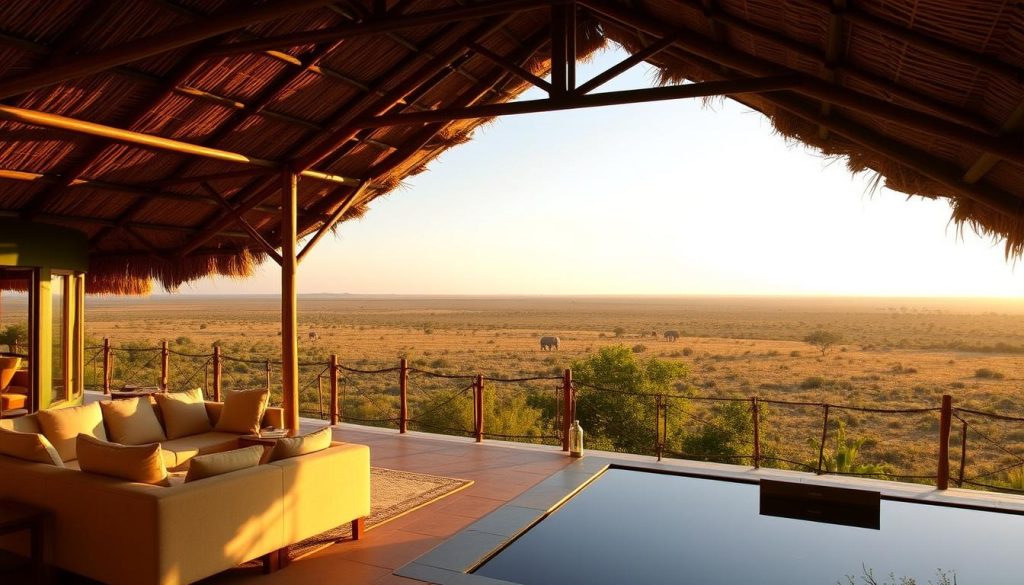
Luxury accommodations offer spectacular views of the savannah
Luxury Lodges
For those seeking comfort in the wilderness, Apoka Safari Lodge offers a premium experience. Perched on a rocky kopje overlooking the Narus Valley, this lodge features ten spacious rooms with private verandas, handcrafted furniture, and en-suite bathrooms with outdoor stone bathtubs. The lodge’s infinity pool seems to merge with the savannah beyond, offering wildlife viewing even while swimming.
Kidepo Savanna Lodge provides another upscale option with comfortable tented suites that blend luxury with an authentic safari feel. The lodge’s elevated position offers panoramic views of the Narus Valley and the mountains beyond.
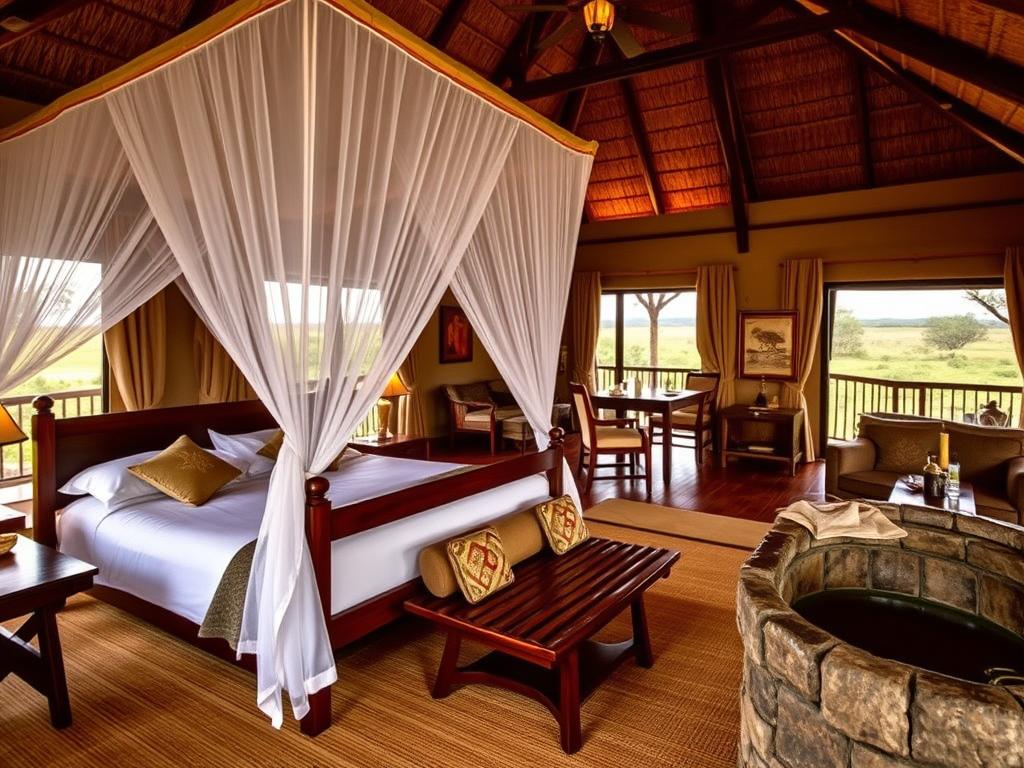
Elegant interiors at Apoka Safari Lodge blend luxury with African design
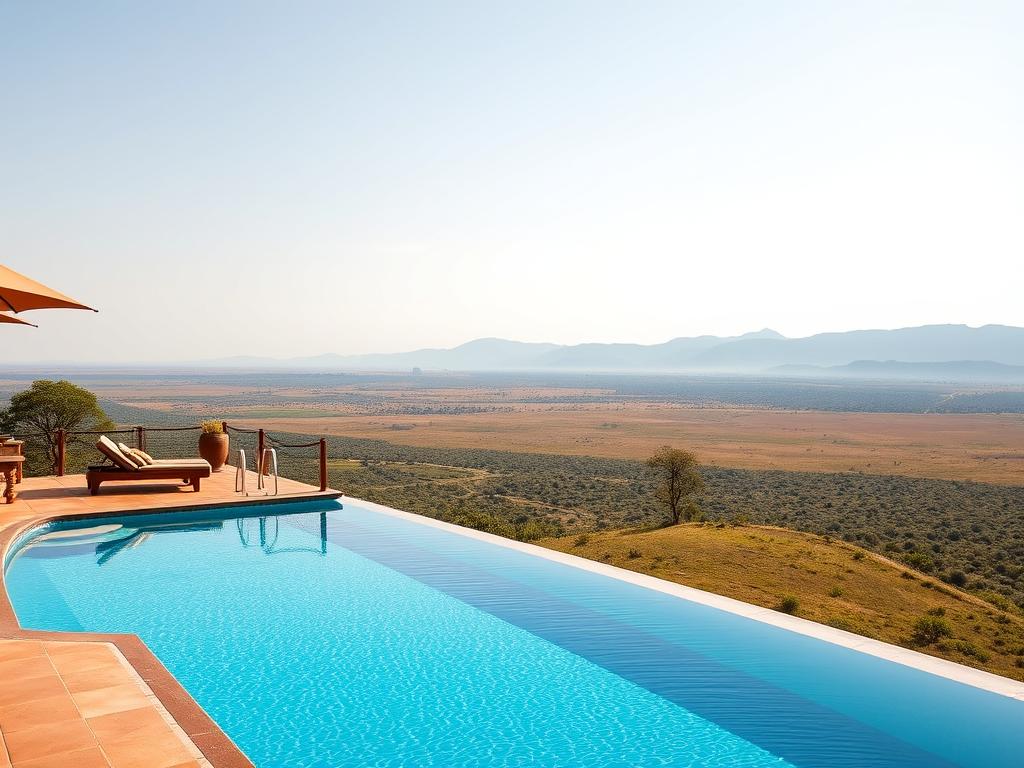
Cool off in an infinity pool while watching wildlife on the plains below
Mid-Range Options
Nga’Moru Wilderness Camp offers comfortable accommodation at a more moderate price point. Located just outside the park boundary, it features safari tents on raised wooden platforms with en-suite bathrooms and private verandas. The camp’s communal areas include a dining tent and campfire area where guests gather to share stories of their day’s adventures.
Adere Safari Lodge provides another mid-range option with a mix of cottages and tents. Its location offers good access to the park while maintaining a connection to the surrounding communities.
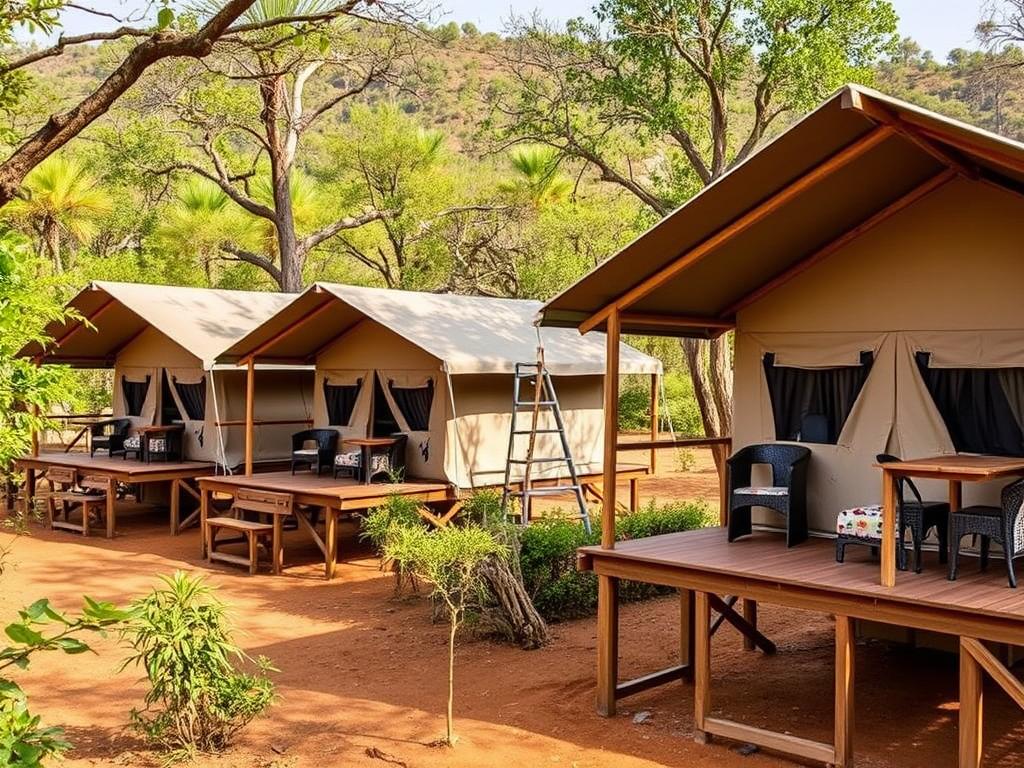
Comfortable safari tents offer an authentic wilderness experience
Budget Accommodation
The Uganda Wildlife Authority manages Apoka Rest Camp within the park, offering simple but clean bandas (cottages) and a campsite. The bandas have basic furnishings and shared bathroom facilities, while the campsite allows visitors to pitch their own tents in a designated area with access to communal bathrooms.
Kidepo Savannah Lodge also offers some budget rooms with more basic amenities than their premium options. These provide a comfortable place to sleep while focusing your budget on activities and experiences.
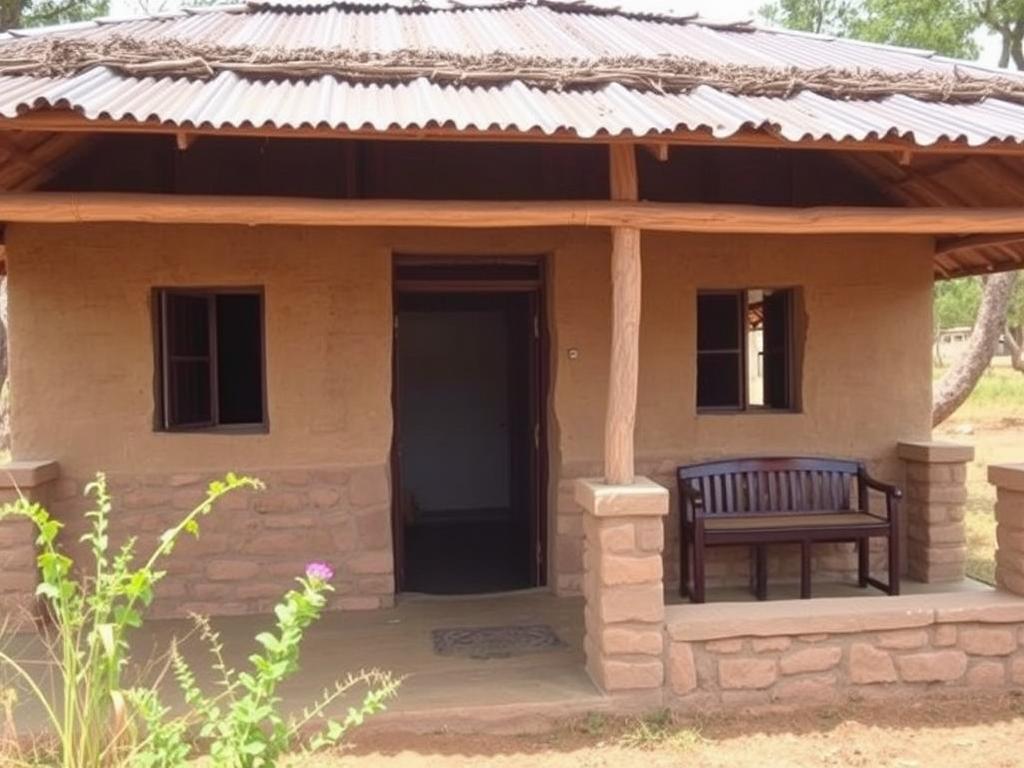
Simple bandas at Apoka Rest Camp provide affordable accommodation within the park
Booking Tips
Due to Kidepo’s remote location and limited accommodation options, it’s essential to book well in advance, especially during the peak dry season (December to February). Most lodges can arrange transportation from major cities or nearby airstrips.
Consider including accommodation in different areas of the park if staying for multiple nights, as this allows you to experience different landscapes and minimize driving time to various attractions.
Many lodges offer full-board packages that include meals and some activities, which can be more economical than paying separately for each component of your stay.
Find Your Perfect Kidepo Accommodation
From luxury lodges to authentic camping experiences, we can help you book the right place to stay.
Essential Travel Tips for Kidepo Valley National Park
Preparing for a trip to Kidepo Valley National Park requires careful planning due to its remote location and wilderness setting. These practical tips will help ensure a smooth and enjoyable safari experience.
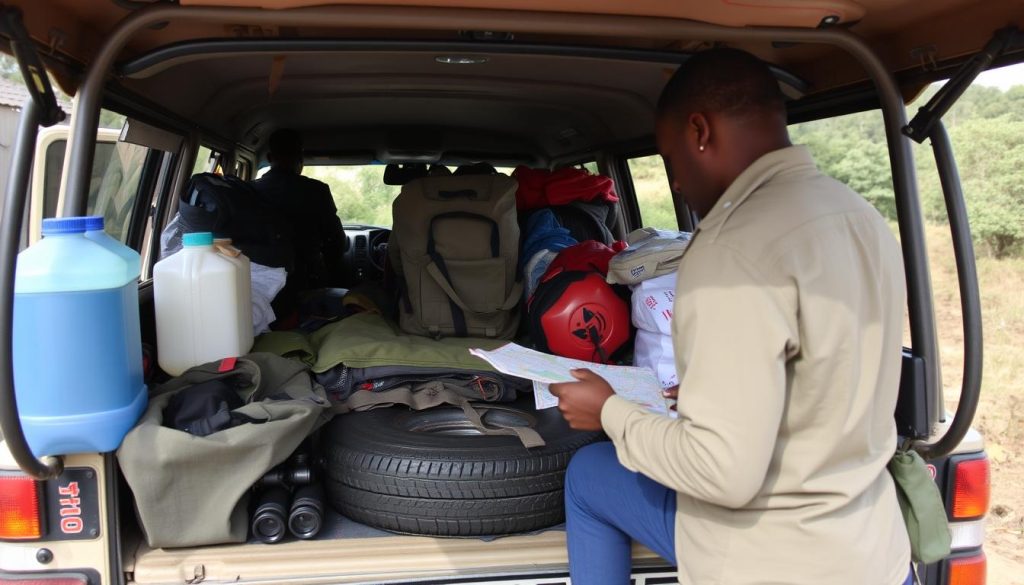
Proper preparation is essential for a successful Kidepo safari
Safety Considerations
Kidepo Valley National Park is a true wilderness area with free-roaming wildlife, including potentially dangerous species. Always follow ranger instructions and never leave your vehicle except at designated areas or when accompanied by an armed guide.
The park’s remote location means medical facilities are limited. Bring a comprehensive first aid kit and any personal medications you might need. Consider purchasing travel insurance that includes emergency evacuation coverage.
While security in and around the park has improved significantly in recent years, it’s advisable to check current conditions before traveling and to use reputable tour operators familiar with the region.
Permits and Fees
Entry permits for Kidepo Valley National Park are required and can be purchased at the park gate or in advance through the Uganda Wildlife Authority. Current fees (subject to change) are:
- Foreign non-residents: $40 per person per day
- Foreign residents: $30 per person per day
- East African citizens: UGX 20,000 per person per day
- Vehicle fees: $30-150 depending on size and registration
Additional fees apply for activities such as guided walks, cultural visits, and specialized birding tours. These can be arranged and paid for at the Apoka Tourism Center within the park.
What to Pack
Packing appropriately for Kidepo’s climate and activities will enhance your comfort and enjoyment:
Clothing
- Lightweight, neutral-colored clothing (avoid bright colors and blue, which attracts tsetse flies)
- Long-sleeved shirts and pants for sun protection and evening insect defense
- Hat with brim for sun protection
- Sturdy walking shoes or hiking boots
- Windbreaker or light jacket for cool mornings and evenings
- Swimwear if your accommodation has a pool
Equipment
- Binoculars (essential for wildlife viewing)
- Camera with zoom lens and extra batteries
- Sunscreen, sunglasses, and lip balm
- Insect repellent containing DEET
- Headlamp or flashlight
- Reusable water bottle
- Small backpack for day trips
Working with Local Guides
Hiring a knowledgeable guide significantly enhances your Kidepo experience. Uganda Wildlife Authority rangers are available for hire at the Apoka Tourism Center and provide valuable insights into wildlife behavior, plant uses, and park history.
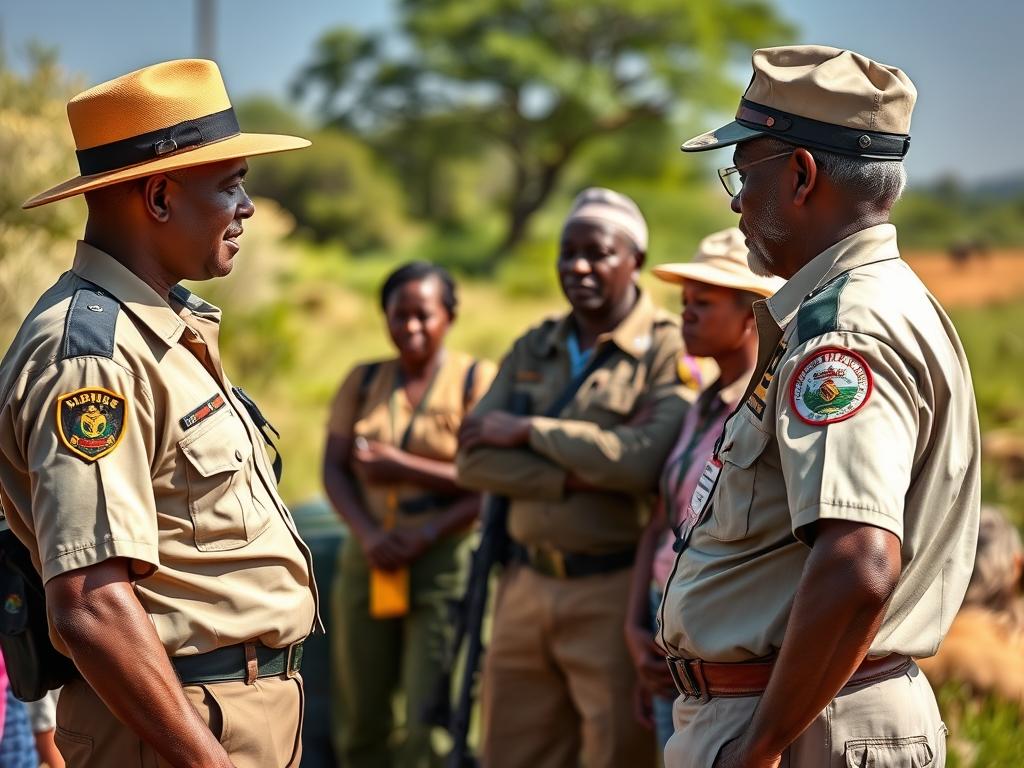
UWA rangers provide invaluable knowledge about the park’s ecosystem
For cultural visits to the Karamojong or Ik communities, local community guides provide authentic perspectives and help navigate cultural protocols. These can be arranged through your accommodation or the park office.
When working with guides, show respect for their expertise and be clear about your interests so they can tailor the experience accordingly. Tipping is customary and appreciated for good service.
Communication and Connectivity
Mobile network coverage in Kidepo Valley National Park is limited and unreliable. Some areas have no signal at all, while others may have intermittent coverage from Ugandan providers like MTN or Airtel.
Most lodges have satellite Wi-Fi available for guests, though it may be slow and restricted to common areas. Consider this an opportunity to disconnect and fully immerse yourself in the wilderness experience.
For safety, inform someone of your travel plans before heading to Kidepo, especially if self-driving. Some tour operators and luxury lodges provide satellite phones or radio communication for emergencies.
Frequently Asked Questions About Kidepo Valley National Park
Is Kidepo Valley National Park worth visiting?
Absolutely! Kidepo Valley National Park offers one of Africa’s most authentic wilderness experiences. Its remote location means fewer visitors and a more exclusive safari experience compared to more accessible parks. The combination of spectacular landscapes, abundant wildlife (including species not found elsewhere in Uganda), and cultural encounters makes it well worth the journey for those seeking an off-the-beaten-path adventure.
How many days do I need to visit Kidepo Valley National Park?
A minimum of 3-4 days is recommended to experience Kidepo properly, considering the time and effort required to reach this remote destination. This allows for multiple game drives in different areas, a nature walk, and possibly a cultural visit. If you’re interested in hiking Mount Morungole or visiting the Kanangorok Hot Springs, consider adding an extra day or two to your itinerary.
What makes Kidepo different from other Ugandan national parks?
Kidepo Valley National Park stands out for several reasons:
- It hosts 28 mammal species not found in any other Ugandan park, including cheetahs and ostriches
- Its semi-arid landscape more closely resembles parks in Kenya and Tanzania than other Ugandan parks
- It’s the only park in Uganda where you can see both zebras and giraffes together
- Its remote location means far fewer visitors and a more exclusive safari experience
- The dramatic mountain backdrop creates some of Uganda’s most spectacular scenery
Is it safe to self-drive to Kidepo Valley National Park?
Self-driving to Kidepo is possible but challenging and recommended only for experienced drivers with 4×4 vehicles and good preparation. The roads are improving but still include long stretches of unpaved surfaces that can become difficult during the rainy season. If self-driving:
- Ensure your vehicle is in excellent condition with spare tires and parts
- Carry extra fuel, water, and food supplies
- Plan your route carefully and inform someone of your itinerary
- Consider breaking the journey with an overnight stop
Many visitors prefer to fly or hire a driver-guide with a suitable vehicle and local knowledge.
What wildlife am I guaranteed to see in Kidepo?
While wildlife sightings can never be guaranteed in any national park, Kidepo offers excellent chances to see:
- Large buffalo herds (often numbering in the hundreds)
- Elephants, especially during the dry season around water sources
- Zebras and various antelope species including hartebeest and waterbuck
- Giraffes browsing among acacia trees
- Numerous bird species, including the ostrich
Predator sightings (lions, leopards, cheetahs) require more patience and luck but are relatively common compared to other parks due to the open terrain and healthy prey populations. The dry season (December-February) offers the best wildlife viewing as animals concentrate around limited water sources.
Experience the Untamed Beauty of Kidepo Valley National Park
Kidepo Valley National Park represents Uganda’s wild frontier – a place where nature exists in magnificent balance, largely untouched by mass tourism. Its remote location has preserved an authentic African wilderness experience that becomes increasingly rare in our connected world.

The magical light of sunset transforms Kidepo into a scene of timeless beauty
For those willing to make the journey, Kidepo offers rewards beyond measure – from intimate wildlife encounters to cultural exchanges with communities who maintain traditional ways of life. The park’s dramatic landscapes provide a backdrop of extraordinary beauty for every experience, whether tracking lions across the savannah or watching the sun set behind Mount Morungole.
As conservation efforts continue to strengthen and infrastructure gradually improves, Kidepo Valley National Park remains poised between accessibility and wilderness – a delicate balance that defines its unique character. Now is the perfect time to discover this remarkable destination before the rest of the world catches on.
Ready to Discover Uganda’s Hidden Gem?
Let us help you plan the perfect Kidepo Valley safari experience tailored to your interests and budget.

